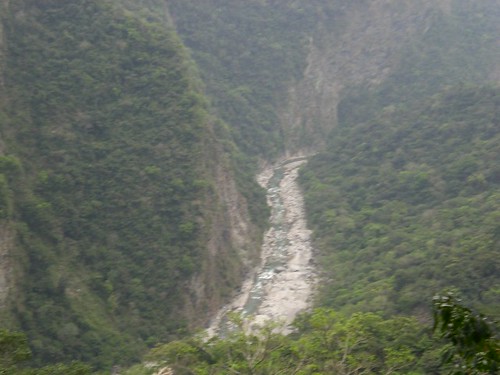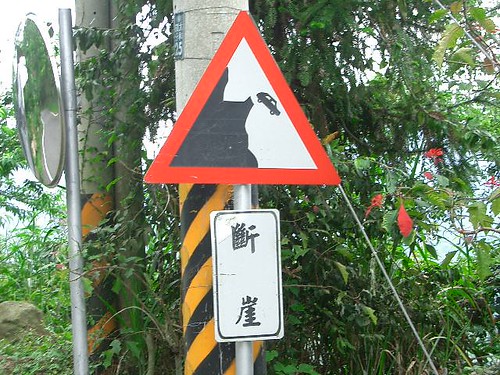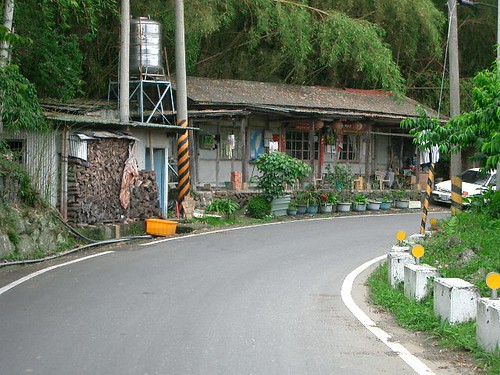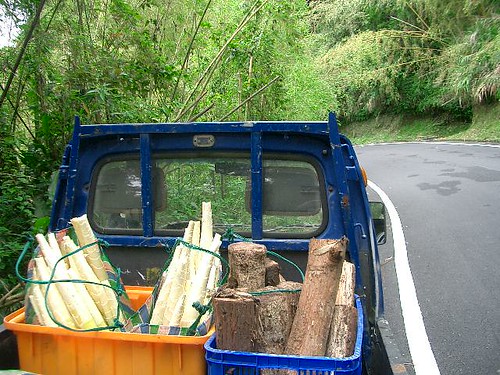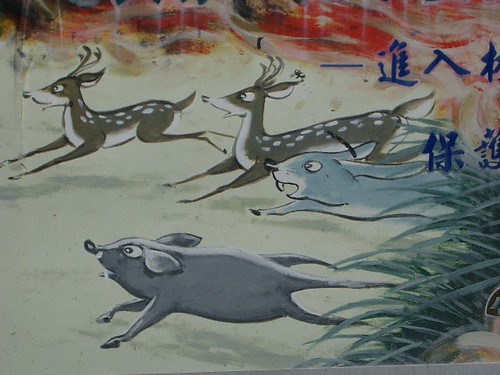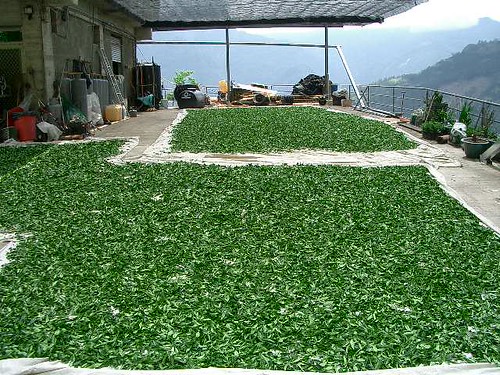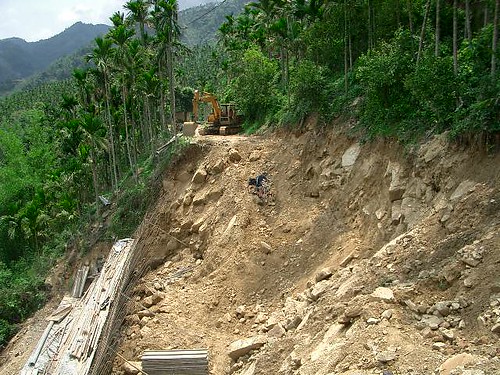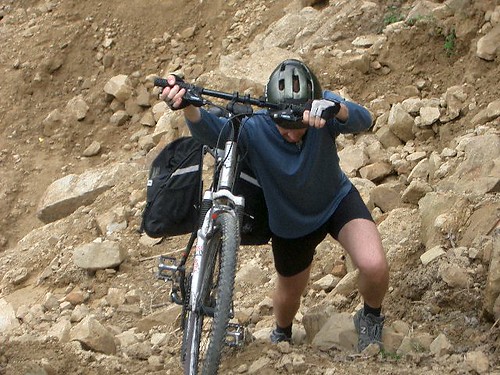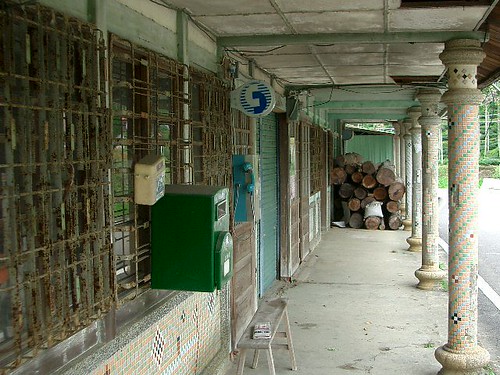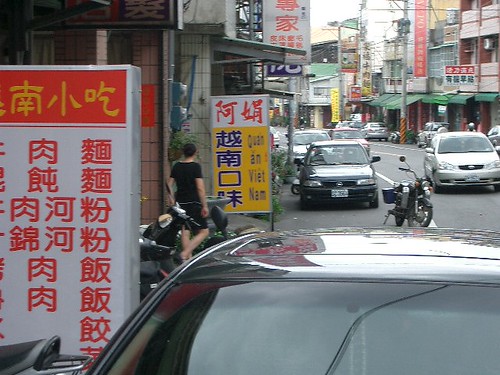Rank originally planned to ride from Shuili 水里 to Chiayi this weekend using the route described in
Great Taiwan Bike Rides IX: Yushan By the Back Roads. A major landslide though blocked our way out of Lugu's (鹿谷) Phoenix Valley (Fenghuanggu 鳳凰谷) above Xinyi (信義) and we were forced to double back toward Xitou (溪投).
As suggested in the linked above, we started from Shuili this time. Getting to Shuili was an adventure in itself. After a late start on the HSR, we arrived at Taichung Station around 8:00pm. A taxi driver suggested that he could take us to a bus station where we could get a bus to Shuili. He ended up taking us all the way into Taichung, where we eventually caught a
All-da (總達客運) bus at 9:00pm at the delightfully funky terminal near Taichung train station. We had to wait for a bus large enough to fit our bikes in the compartment below as most buses to Shuili are small commuter buses. You can call the station on the day you will ride to check when the large bus will be going to Shuili. There is no definite schedule.
Unfortunately, the bus to Shuili goes everywhere in northern Nantou County before arriving in Shuili three hours (!) later. We could have rode from the HSR station to Shuili faster than that. I now realize that the best way to get to Shuili would be to take Taiwan Railways Jiji line (集集線) from the New Wuri Station (新烏日) adjacent to the Taichung HSR Station (Exit 3, Floor 2). The 3821 local, for example. stops in Wuri at 8:15pm and arrives in Shuili at 9:38pm. Bicycles must be bagged for both the HSR and local commuter trains.
After camping in a field a few kilometers downhill from Shuili on County Road 131, we cycled pleasantly up 131 t0 151, where we had lunch in Lugu. 151 is to be avoided wherever possible. It is a two-lane road full of traffic headed for the resort town of Xitou. If you are from northern Taiwan, it is a lot like Yangde Boulevard (陽德大道) heading up Yangmingshan. Fortunatel there are many side roads like 131. 131, incidentally, is a designated bike route that runs all the way from Puli to Lugu. This looks like it might well be a good intermediate ride through hilly but not too steep countryside. The junction with 151 is at about 350 meters. If you look closely at the
map of the junction area, you should be able to see some alternative routes that will cut down your time on 131.
Just after Lugu Elementary School (鹿谷國小), we turned left on Renyi Road (仁義), also known as Nantou Route 56, and headed toward Phoenix Valley, which is in fact a beautiful gorge with excellent swimming holes at the bottom. The road eventually peters out at a place called Tiandi 田底 (not shown on Google Maps), and you turn right and go up the hill. Unfortunately, about .5km in there is a massive landslide that now blocks access to Xinyi and Highway 21 (see this this
news report in Chinese). The slide is 500 meters across and 100 meters deep but may be passable for the very adventorous since the mountain has slid away leaving mostly bare rock. The main problem would be getting down from the edge of the road to the surface of the slide area about 3 meters below. Note that Google Maps is very inaccurate in this area--the Nantou road map at 711 is much better. Maximum altitude at top of the gorge is around 850 meters.
We doubled back to Renyi Rd. and took a left just after Fenghuang Elementary School (鳳凰國小) at 700 meters on
Ertu Rd., which comes out on 151 in the pleasant town of Guangxing (廣興) at 500 meters. From here, we took Guangfu Rd. (光復) at the 711 down to the river and then hung a left after crossing the river onto Aixiang Rd (愛鄉). Guangfu, incidentally looks like a good alternative route to 151 from Jhushan (竹山). A few kilometers before Hanya (和雅) we camped in a bamboo grove off the road at about 750 meters.
The next morning we took Aixiang Rd. all the way to the last junnction with 151 and on to Xitou at about 1100 meters where we had breakfast. From there,
Sishan Rd. (溪山) road took us up a series of moderately difficult switchbacks to a pass at 1800 meters. Here we turned right on Nantou 47 (投47線), which is marked on Google Maps as the Da'an Forestry Rd. (大鞍林道)
Sanchalun Branch (三叉崙支線). The terraced teafields along this spectacular road are know as the Heavenly Ladder (天梯) and for good reason. Bring your camera. Despite the forestry road moniker, these roads are roughly paved with concrete. Road bikes not advised although my hybrid with 1.25" slicks did fine.
Originally we had planned to take Nantou 54 (投54線) down 36km to 149A (149甲) in Caoling (草嶺) and on to Fencihu, but a landslide before the
junction forced us to make a difficult detour through the tea fields above the slide. With just a few hours of daylight left, we enjoyed the long downhill into Jhushan on 47. Note this
news report from October of this year reporting another slide further down 54. 54 is marked as the main branch of the Da'an Forestry Rd. on Google Maps. Given the very steep terrain and the many slides, Rank highly recommends placing a few phone calls to local village chiefs in the area or doing other research to find out which roads are in fact open. The slides we saw will probably not be fixed until the summer.
Reaching Jhushan, we quickly located the
Ubus Bus Station on Highway 3. Alas, posted prominently in the window was a sign stating that Ubus will now accept only bagged collapsible bicycles. We had send our bike bags home, but the station personnel told us that they were very strict about only collapsible bikes. This is another unfortunate consequence of the biking craze in Taiwan.
But repairing to a local internet cafe to study our options, Rank soon realized that a whole host of secondary train stations now will ship bicycles (託運). This service used to be restricted to main stations that shipped scooters. These services have now be decoupled. As a result, the tiny town of Linnei (林內) just across river on Highway 3 (see
area map) was able to send our bikes to back to Taipei. We caught at 4:30 pm train and, after a change in Yuanlin, were back in Taipei by 8:30pm.
The many back roads, the dry, sunny winter weather, and improved bike transportation in this area mean that Rank will be back in this area soon to explore more routes soon.

